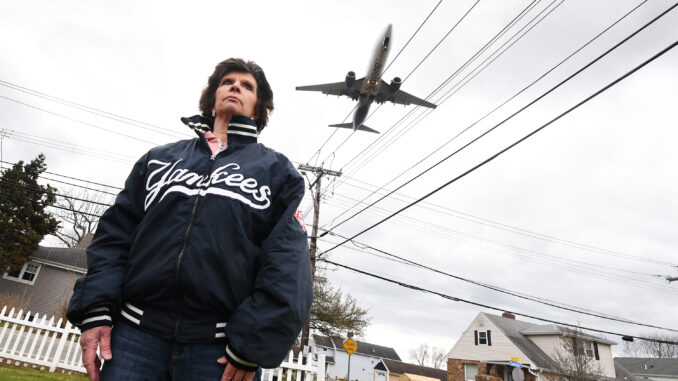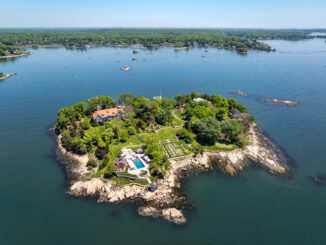
Tweed New Haven in Connecticut is an oddity of an airport — plunked down smack in the middle of a residential neighborhood.
Nearby neighbors awaken early — generally at 6:30 a.m., when the day’s first jet blasts off. And they stay up late — the last jet arrives at 10:30 p.m., assuming no delays.
The noise, they say, is torture. It rattles their eardrums, vibrates their houses and frightens their pets.
“Nobody needs an alarm to wake up anymore,” said Debbie Bradley, who lives directly beneath the flight path. “You can’t sleep. You can’t enjoy peace in your house. You can’t sit outside on your deck.”
When Bradley bought her house in the late ‘80s, the airport served mostly daytime puddle jumpers. “It never bothered me,” she said.
“Now, they are killing our quality of life. It was fine before they started wooing people with cheap flights, but those people don’t have to live with this 24 hours a day.”
Bradley and other stressed-out neighbors are bracing for the worst. For the last two and a half years, Tweed, a small regional airport since its opening in 1931, has been a hub for Avelo Airlines, which runs bargain flights primarily to Florida. (A no-frills ticket between New Haven and Orlando is as low as $81.)
Currently, Tweed sees an average of 19 flights a day, inbound and outbound, not counting corporate jets and non-commercial flights. Since Avelo arrived, Tweed has seen air traffic increase eleven-fold.
A contentious fight over a proposed expansion plan is ongoing. The houses nearest the airport are modest ranches and Capes on pokey residential streets: the speed limit is 25 miles per hour. Many of those residents are trying to stop the expansion, worried that the problems — noise, traffic, fumes — will only worsen.
For 30 years, Laura McHugh has lived directly across from the airport. “The planes idle right in front of my picture window,” she said, as they await other landings or takeoffs. “The fumes smell terrible. They burn your eyes. My birdbath is full of oil.”
Emergencies or delays mean flights arrive in the wee hours. East Haven lies in a basin, prone to flooding. Planes sometimes circle in dense fog until it is safe to land.
Enormous jet-fuel trucks block the streets — and cars idle, backed up for dropoff or pickup. Sometimes they block people’s driveways.
“Across the street from the airport, you have people standing outside waiting for an Uber at 10 p.m. with a suitcase,” said Lorena Venegas, an anti-expansion activist.
Tweed New Haven — named for its first airport manager, Jack Tweed — historically had few flights, limited by the relatively short runway of 5,600 feet. A second runway is no longer in use.
After Walter Fritsch retired as a letter carrier in 1997, he took a short-lived job at the airport’s coffee stand. After eight months, business was so slow that “they decided to do away with the concession,” said Fritsch, a 50-year East Haven resident.
The current concession stand is open for all departing flights.
The expansion plan would lengthen the runway, which straddles the border of New Haven and East Haven, allowing for bigger and heavier jets. Avelo flies Boeing 737-800Ws. On the current runway, takeoff requires extra thrust, making takeoff extra loud.
The expansion plan also includes a new terminal — to be built on piers — that would move from the New Haven side to the East Haven side, on what is now mostly unoccupied wetlands. A new parking structure would have 4,000 spots, double the current capacity.
“At this point, there needs to be a full and detailed environmental study,” said Roger Reynolds, senior legal director of Save the Sound, a regional environmental nonprofit.
The current environmental assessment says that a longer runway would mean larger but fewer planes, creating less environmental impact. “That flies in the face of reality,” Reynolds said.
“The increased capacity will logically lead to more flights from larger airplanes, which will worsen air quality and increase environmental impacts,” Reynolds said.
Not so, countered the airport’s spokesman, Andrew King. He insists that modern technology and electrified operations would lessen the airport’s impact, too.
As for noise, “the lengthened runway will, at first, shorten the noise cone around the airport and will ultimately reduce the number of houses impacted by 17%,” King said.
Nearly 200 properties within the noise-impact zone were offered soundproofing in the past, with an average of $42,800 spent per house. Further plans are in the works, one of which would offer a “sound protection grant” of $8,700 to qualified houses.
Neighbors also complain of jet-fuel smells and airborne particles that leave residue on their cars and roofs. “My husband and I — all we do is cough,” said Joelle Marie Innocenti. “We are always on Flonase. A good number of us are really miserable.”
Currently, there are two pending court appeals of the Federal Aviation Administration’s decision that the project can continue.
The common counterargument: You knew the airport was there when you moved in.
But homebuyers “had no idea of the manner in which the airport would expand,” Venegas said.
The airport was not supposed to grow, she said. In 2019, an appeals court ruled that federal aviation law preempted a state law that prevented the extension of the runway. In 2020, the US Supreme Court declined to review the case.
“I am not against the airplanes,” Venegas said. “I call this the wrong airplane on the wrong runway. This is a JFK plane. That’s where it needs to land.”
Another common argument: If you don’t like the situation, you can move. That’s what Gabriela Campos felt forced to do.
Until last fall, she lived a block from the airport. Even with soundproofing — the old windows worked better than the new ones, she said — fumes penetrated the house. “I had an air purifier going all the time,” she said. “Some people aren’t so sensitive. Good for them, but some of us are.”
To escape the foul air that bothered her asthmatic son, she moved her family farther away, but still within the same school district.
The buyers of her house wanted to live conveniently near the airport, she said.
For some, that convenience can’t be beat.
Claire Carrano’s family has lived in East Haven all their lives. Carrano hasn’t yet used Tweed, but her sister, who lives right near the runway, “told me how great it was to be able to just walk to catch a flight,” she said. “They travel light enough to walk.”
Growing up in East Haven, Carrano spent many a happy childhood day watching planes.
“For the 30 seconds or less that the airplanes go overhead, they do not bother me in the least,” she said. “I hardly hear them at all. I have no issues with the airport.”













